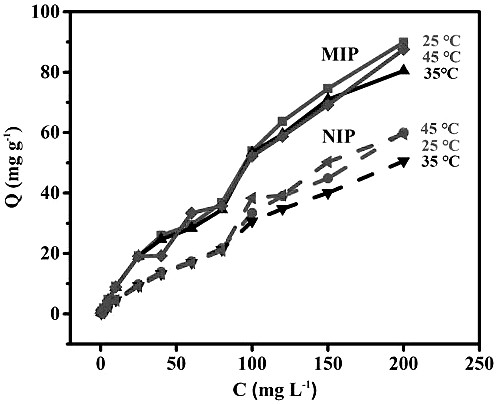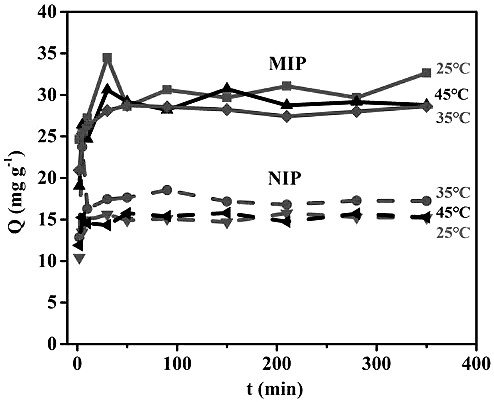A method for preparing diclofenac sodium surface molecularly imprinted polymer in aqueous phase using zif-67 as carrier
A technology of surface molecular imprinting and ZIF-67, which is applied in the direction of chemical instruments and methods, and other chemical processes, to achieve the effect of low cost, good selection and recognition ability, and uniform particle size
- Summary
- Abstract
- Description
- Claims
- Application Information
AI Technical Summary
Problems solved by technology
Method used
Image
Examples
Embodiment 1
[0020] In a 250 mL Erlenmeyer flask, add 0.1776 g of 1-allyl-3-vinylimidazole tetrafluoroborate, 0.1593 g of diclofenac sodium, 0.2 g of ZIF-67 and 50 mL of pure water, shake at 30 °C After 4 hours of polymerization, 1.8500 g of N,N'-methylenebisacrylamide and 10 mg of azobisisobutyronitrile were added sequentially, and the polymerization reaction was shaken at 60°C in a water bath for 24 hours, and the obtained product was mixed with methanol / acetic acid (V : V=9:1) Soxhlet extraction for 48 h to remove diclofenac sodium, then washed with methanol until neutral, and then dried in vacuum at 60°C to obtain the target product diclofenac sodium surface molecularly imprinted polymer. The preparation method of the non-molecularly imprinted polymer on the surface of diclofenac sodium is the same as above, except that diclofenac sodium is not added in the process.
Embodiment 2
[0022] In a 250 mL Erlenmeyer flask, add 0.222 g of 1-allyl-3-vinylimidazole tetrafluoroborate, 0.1593 g of diclofenac sodium, 0.3 g of ZIF-67 and 50 mL of pure water, shake at 30°C for pre- After 4 hours of polymerization, 1.5418 g of N,N'-methylenebisacrylamide and 10 mg of azobisisobutyronitrile were sequentially added, and the polymerization reaction was shaken at 60°C in a water bath for 24 hours, and the obtained product was mixed with methanol / acetic acid (V : V=9:1) Soxhlet extraction for 48 h to remove diclofenac sodium, then washed with methanol until neutral, and then dried in vacuum at 60°C to obtain the target product diclofenac sodium surface molecularly imprinted polymer. The preparation method of the non-molecularly imprinted polymer on the surface of diclofenac sodium is the same as above, except that diclofenac sodium is not added in the process.
Embodiment 3
[0024] In a 250 mL Erlenmeyer flask, add 0.2664 g of 1-allyl-3-vinylimidazole tetrafluoroborate, 0.1593 g of diclofenac sodium, 0.3 g of ZIF-67 and 50 mL of pure water, shake at 30 °C After 4 hours of polymerization, 1.5418 g of N,N'-methylenebisacrylamide and 10 mg of azobisisobutyronitrile were sequentially added, and the polymerization reaction was shaken at 60°C in a water bath for 24 hours, and the obtained product was mixed with methanol / acetic acid (V : V=9:1) Soxhlet extraction for 48 h to remove diclofenac sodium, then washed with methanol until neutral, and then dried in vacuum at 60°C to obtain the target product diclofenac sodium surface molecularly imprinted polymer. The preparation method of the non-molecularly imprinted polymer on the surface of diclofenac sodium is the same as above, except that diclofenac sodium is not added in the process.
PUM
 Login to View More
Login to View More Abstract
Description
Claims
Application Information
 Login to View More
Login to View More - R&D
- Intellectual Property
- Life Sciences
- Materials
- Tech Scout
- Unparalleled Data Quality
- Higher Quality Content
- 60% Fewer Hallucinations
Browse by: Latest US Patents, China's latest patents, Technical Efficacy Thesaurus, Application Domain, Technology Topic, Popular Technical Reports.
© 2025 PatSnap. All rights reserved.Legal|Privacy policy|Modern Slavery Act Transparency Statement|Sitemap|About US| Contact US: help@patsnap.com


